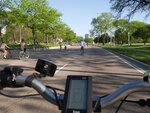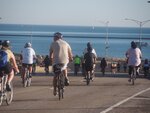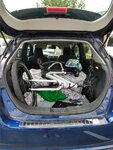@Craig - We have a 2018 Leaf (electric car), and a 2017 Prius 4 Touring hybrid - both are hatchbacks. The bike fits nicely into both cars with the back seats down, and I can easily lift it inside myself (age 66, but then again I have horses/ponies and can pick up and throw hay bales pretty easily, too...for now!). The back wheel goes in first and simply rolls along on its edge until the back wheel is behind the passenger seat. Plenty of room for the handlebars when closing the hatchback, and plenty of room for the front wheel either under the front fork (Prius) or standing up alongside the interior rear wall (Leaf) with Velcro wrapped around the wheel through the back seat latch on the wall to hold the wheel firmly in place.
ZERO risks to any components because the bike has a carbon belt drive (no derailleur, no chain, no risk of dirty oil (chain) touching anything inside the car), brakes are disk, and shifting is a single handgrip twist. No protruding parts at all.
This setup works perfectly for me. I can chose either car at a moments notice to transport my bike and I don't need special equipment to do so. My bike is protected from the elements, road debris, and safely secured if I want to leave the car somewhere. Which means I have zero worries because no one can touch it, AND I don't have to deal with a bike rack being in the way of accessing the cargo space in my hatchbacks.
I have also found (much to my delight) that when I start to unload the bike and the back rack is past the top of frame where the hatchback is attached, the bike can then "sit up" straight in the cargo area with the motor resting on the rear latch, without any one holding the bike, so that I can easily slip the front wheel on before I finish unloading. That was a surprising and much appreciated finding.
Pics:
Leaf (blue car) specs: 30 cubic feet with back seats down (176″ L x 71″ W x 61-62″ H)
Prius (red car) specs: 27.4 cubic feet w/back seats down (179″ L x 69″ W x 58″ H)
The photo of the LaFree in the Prius (red car) was taken in mid May shortly after I purchased the bike, and before we tweaked the handlebars to be more upright for my comfort. It was a tight fit and required the front wheel to be turned facing backwards, but it did fit. Once the handlebar was changed, however, the bike no longer fit in the car with the wheel on the front. But fits quite nicely (actually better with more room) with the front wheel off.
We had the LaFree in the Leaf at an electric car gathering during Drive Electric Week this fall. The ebike was a big hit and actually garnered more interest and questions from the crowds than the ecar!

Edited to add: have no idea what the front wheel weighs. 3-4lbs?? Next time I have it off, I'll weigh it to see exactly how many lbs of bike I'm lifting into the car with the wheel and battery both off.








